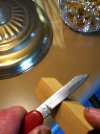What _____ to maintain an edge
I would like some freehand _____ to avoid the hassle of setting up the wicked edge.
I timed how long it took to go get my Edge Pro Apex and the jeweler's magnification visor (so I could see that super fine minutest sharpening bur that tells me I am on the apex).
. . . and set up the Edge Pro including wetting and putting in the 4,000 Shapton Glass stone, marking the bevel with Magic Marker and adjusting the angle so I am right down on the very apex:
2 minutes 34 seconds and I'm not in a mood for hurrying in the least today. I did too much of that all week.
And this is a knife that has never been in the Edge Pro or on any other jig. A brand new knife that I have only just used from the factory (so I had little idea of where to put the adjustment).
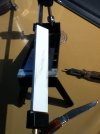
Alternatively what I do to touch up a blade that is near shave sharp and take it back to frighteningly hair whittling ( couldn't do much, if any, better with a strop or hand held on any other stone) is the Spyderco Ultra Fine Ceramic triangle rod. It doesn't remove the bur on all alloys so for those I use the chunk of Norton 8,000 stone shown in the last photos.
Anyway I orient the edge under a light where I can see any bur / roll now or that I am creating. I
pull the rod toward me and with practice I can (with fairly high magnification from the visor) see when I am on the apex and creating the very faintest sharpening bur.
Once that is created all along the edge I put the stone on top of the blade with just the weight of the rod and pull the rod toward me to take the bur down. Just a stroke or two or three.
I put the rod under the blade again and with one or two strokes raise the bur back to that side.
This will show me where any areas that are more dull or rolled or nicked are and I can work those with the corner of the triangle rod to "steel" them or other wise reform them and sharpen them (sometimes takes a steeper angle in that area). This "fixing" of the flaws, rolls and nicks is something that a strop can't really do. The flaws just scrape compound off the strop but that's about it.
Once I get a decent bur on both sides (flip the knife over to see the bur as needed) then I can take the flat of the triangle once again and go against the edge (edge leading) to take off the bur and then some more edge trailing ever so lightly to refine the edge.
If the bur is gone I am done if the bur won't come off I go to the Norton 8,000 stone below and repeat. It never fails to take off stubborn burs; mostly on stainless steel blades.
That is M4 on the Para2 and the triangle is always all I need to remove ALL the bur and touch up the edge to a very pleasing hair whittling or even tree topping sharpness.
Strops have a hard time removing rolls or heavier burs so for that reason the stones are the way to go for touch up. And for me at least the only way to go
ever for a final edge unless I am doing a full resharpening then the edge off the jig (Edge Pro) is all I could ever dream of; just a brilliantly sharp, quality edge . . . cutting wise anyway.
Pull the rod toward you a few times while watching and minutely adjusting the angle until the faintest bur forms (assuming this is a fairly sharp knife; not dull).

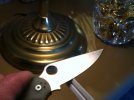
Once the slightest bur is showing all along the edge put the stone on top and pull the least amount that it takes to knock the bur down. Switch to the flats of the triangle rod and repeat.
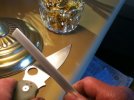
Can't get rid of the bur with final edge leading strokes on the ceramic rod ? Go to Norton 8,000 and do same MO.
Pretty much I never go edge leading on the Norton it is too soft without perfect technique. But edge trailing gets rid of the bur.
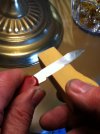
PS: if the flat of the Norton 8,000 isn't doing it I some times resort to the corner of the stone as the corner of the triangle rod is used. I have smoothed and prepared the corners of the stone on a more coarse diamond plate just for that purpose.
